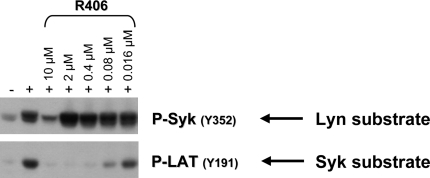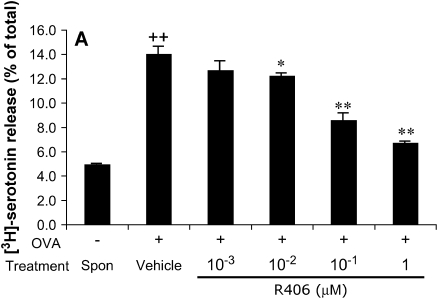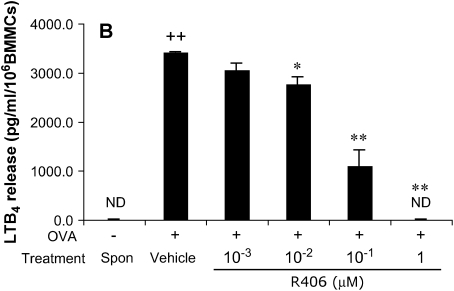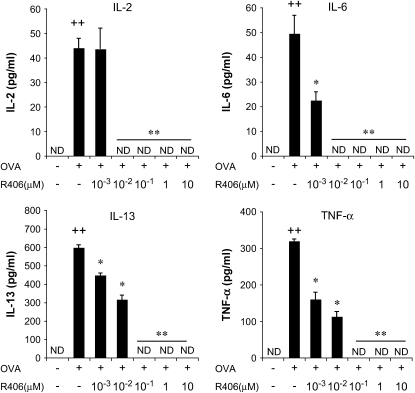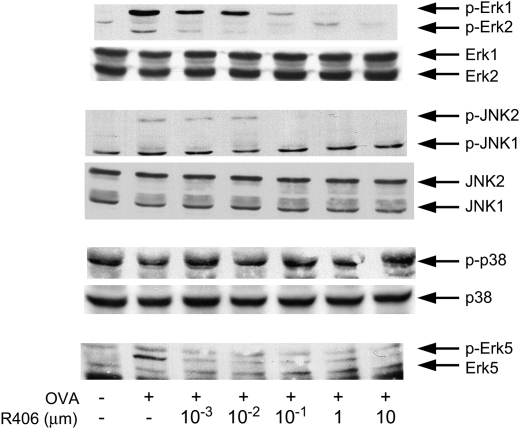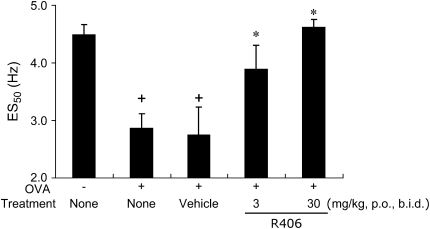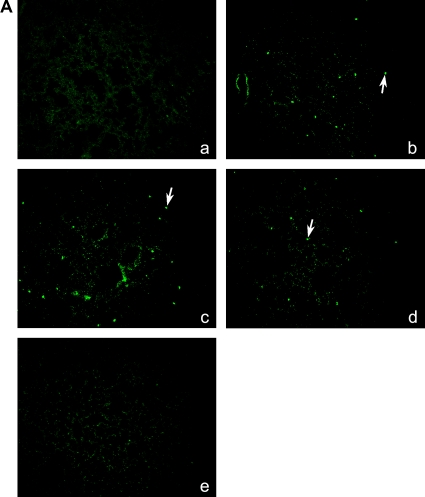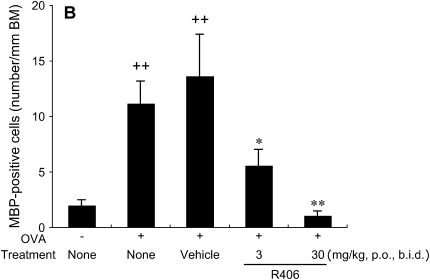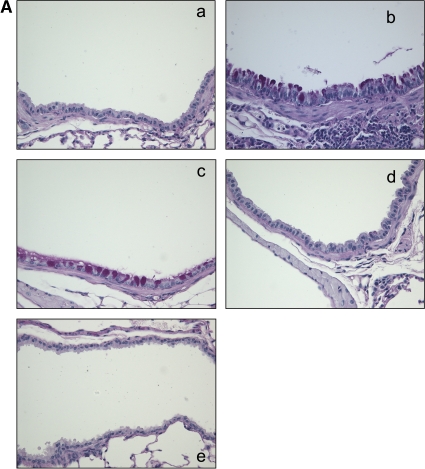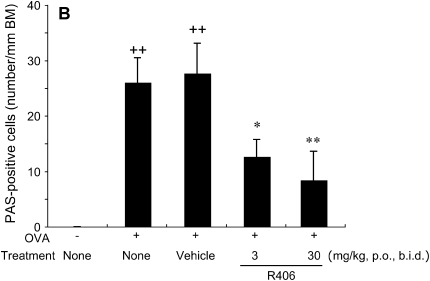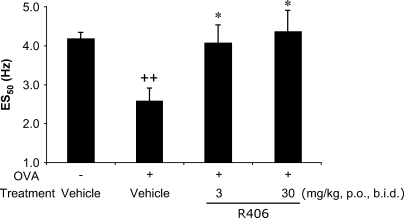Abstract
Rationale: Spleen tyrosine kinase (Syk) is important for Fc and B-cell receptor–mediated signaling.
Objective: To determine the activity of a specific Syk inhibitor (R406) on mast cell activation in vitro and on the development of allergen-induced airway hyperresponsiveness (AHR) and inflammation in vivo.
Methods: AHR and inflammation were induced after 10 d of allergen (ovalbumin [OVA]) exposure exclusively via the airways and in the absence of adjuvant. This approach was previously established to be IgE, FcɛRI, and mast cell dependent. Alternatively, mice were passively sensitized with OVA-specific IgE, followed by limited airway challenge. In vitro, the inhibitor was added to cultures of IgE-sensitized bone marrow–derived mast cells (BMMCs) before cross-linking with allergen.
Results: The inhibitor prevented OVA-induced degranulation of passively IgE-sensitized murine BMMCs and inhibited the production of interleukin (IL)-13, tumor necrosis factor α, IL-2, and IL-6 in these sensitized BMMCs. When administered in vivo, R406 inhibited AHR, which developed in BALB/c mice exposed to aerosolized 1% OVA for 10 consecutive d (20 min/d), as well as pulmonary eosinophilia and goblet cell metaplasia. A similar inhibition of AHR was demonstrated in mice passively sensitized with OVA-specific IgE and exposed to limited airway challenge.
Conclusion: This study delineates a functional role for Syk in the development of mast cell– and IgE-mediated AHR and airway inflammation, and these results indicate that inhibition of Syk may be a target in the treatment of allergic asthma.
Keywords: airway hyperresponsiveness, eosinophils, goblet cell metaplasia, mast cells, spleen tyrosine kinase
Bronchial asthma is a complex disease characterized by reversible airway obstruction, chronic airway inflammation, and airway hyperresponsiveness (AHR). During an asthmatic reaction, several cell types, including Th2 cells, eosinophils, and mast cells, are recruited, activated, and stimulated to release cytokines and chemokines, contributing to increased airway inflammation and altered airway function (1). Increasingly, complex roles for mast cells are described in the development and persistence of allergic airway disease. Mast cells have been described in increased numbers in the airway wall, and recent reports have found these cells infiltrating airway smooth muscle of asthmatics (2). Mast cells express high-affinity surface receptors for IgE and FcɛRI, and cross-linking of receptor-bound IgE with multivalent antigen initiates the activation of mast cells by promoting the aggregation of FcɛRI (3, 4). This activation signal initiates cascades leading to degranulation and cytokine release, which further contribute to the development and maintenance of allergic inflammation (5). Inhibition of the IgE–mast cell pathway is described to improve asthma (1).
Spleen tyrosine kinase (Syk) plays an essential role in the signal-transduction cascade initiated after FcɛRI aggregation as shown in Syk-deficient mast cells, which are defective in receptor- induced degranulation, cytokine synthesis, and intracellular signaling-pathway activation (6–8). Piceatannol, a Syk inhibitor, inhibited allergen-induced anaphylactic contraction of isolated guinea pig bronchi and the release of histamine and peptidoleukotrienes from lung preparations (9). Furthermore, Yamamoto and colleagues (10) demonstrated that an orally available Syk inhibitor was effective in reducing allergic inflammation and bronchoconstriction in rats. On the basis of these findings, Syk inhibition could be an important target for preventing allergen-induced airway inflammation, which leads to AHR.
In this study, we show the effects of a specific Syk kinase inhibitor in preventing mast cell activation, degranulation, and cytokine production in vitro as well as inhibiting the development of mast cell–dependent AHR and airway inflammation in vivo. To evaluate this compound on AHR, we used an allergen challenge protocol in which mice were challenged repeatedly with allergen via the airways without the use of an adjuvant (11) or were passively sensitized with IgE specific for ovalbumin (OVA) and then exposed to limited airway challenge (12, 13). AHR development in these models was previously demonstrated to be dependent on IgE, FcɛRI, and mast cells (12). Some of the results of these studies have been previously reported in the form of an abstract (14).
METHODS
Animals and Cells
Female BALB/c mice (Jackson Laboratories, Bar Harbor, ME), 8 to 12 wk of age, were maintained on an OVA-free diet. All experimental animals used in this study were under a protocol approved by the Institutional Animal Care and Use Committee of the National Jewish Medical and Research Center.
To obtain bone marrow–derived mast cells (BMMCs), bone marrow cells taken from mouse femurs were incubated in Iscove's modified Dulbecco's medium plus 10% fetal calf serum, 1% interleukin (IL)-3 conditioned medium, 2% stem cell factor–conditioned medium, 50 μM 2-mercaptoethanol, 2 mM glutamine, 100 μg/ml streptomycin, and 100 U/ml penicillin for 4 to 6 wk as described (12). FcɛRI and c-kit expression levels were determined by flow cytometry to assess mast cell purity, which exceeded 95%.
R406
The small molecule R406 was identified as a potent inhibitor of FcɛRI-dependent mast cell activation (EC50 = 43 nM) using cell-based structure–activity relationships with primary human mast cells. The primary target for R406 was found to be Syk. R406 is an ATP-competitive inhibitor of Syk activity (Ki = 30 nM). In BMMCs activated by FcɛRI cross-linking, R406 inhibited the phosphorylation of linker for activation of T-cell tyrosine residue Y191 (a Syk substrate) about 50-fold more potently than the phosphorylation of Syk itself, which is phosphorylated by Lyn kinase (Figure 1). In addition, R406 was selective as assessed using a panel of cell-based assays representing both specific and general signaling pathways (E.S. Masuda, manuscript in preparation).
Figure 1.
R406 selectively inhibits spleen tyrosine kinase (Syk) in bone marrow mast cells (BMMCs). BMMCs were sensitized with IgE and then incubated with different concentrations of R406 for 1 h before adding antigen. Phosphorylation of Syk and linker for activation of T-cell tyrosine residue Y191 (LAT) was monitored by Western blot using anti–phosphotyrosine-specific antibodies.
Degranulation Assay
BMMCs were incubated overnight at approximately 5 × 106 cells/ml together with 500 ng/ml of anti-OVA IgE (13) and 2 μCi/ml [3H]-serotonin (Amersham, Arlington Heights, IL). Cells were then washed twice with Tyrode's buffer to remove excess IgE and [3H]-serotonin. The cells were plated at 1 × 106 cells/well and incubated with R406 for 1 h; 10 μg/ml of OVA (Sigma, St. Louis, MO) was then added for 30 min at 37°C, and then cells were placed on ice before centrifugation. Release of [3H]-serotonin into the supernates and in cell lysates was determined in triplicate by liquid scintillation, and the percentage of radioactivity in supernates was calculated.
Detection of Cytokines and Leukotriene B4
BMMCs (5 × 106 cells/ml) were incubated with 500 ng/ml of anti-OVA IgE overnight and washed twice with prewarmed completed medium. The cells were then treated with R406 at the concentration indicated for 1 h before addition of OVA; cells were cultured together with OVA (10 μg/ml) for 24 h in the presence of R406. The supernatants were collected, and secreted IL-2, IL-6, IL-13, and tumor necrosis factor (TNF)-α levels were determined using a murine-specific ELISA detection kit (R&D Systems, Minneapolis, MN). For leukotriene B4 (LTB4) assays, BMMC were treated in a similar fashion and culture supernates were obtained after 1 h culture with OVA. LTB4 levels were assayed by ELISA (R&D Systems).
Immunoblotting for Mitogen-activated Protein Kinases
BMMCs were passively sensitized with OVA-specific IgE antibodies after incubation at 37°C overnight and washed twice with prewarmed completed medium. Cells were then treated with R406 for 1 h before addition of OVA for 15 min. BMMC were harvested by centrifugation at 500 × g for 5 min at 4°C. Cell pellets were lysed with lysis buffer (20 mM Tris-HCl, pH 7.6; 0.5% Nonidet P-40; 0.25 M sodium chloride; 3 mM ethylenediaminetetraacetic acid; 3 mM ethyleneglycol-bis- (β-aminoethyl ether)-N,N′-tetraacetic acid, 1 mM phenylmethylsulfonyl fluoride, 2 mM sodium orthovanadate, 20 μg/ml aprotinin, 5 μg/ml leupeptin, 1 mM dithiothreitol). Cell lysates were analyzed by sodium dodecyl sulfate–polyacrylamide gel electrophoresis and blotted onto polyvinylidene fluoride membranes. Anti–phospho-extracellular-regulated kinase (ERK)1/2 and p38 antibodies (Cell Signaling Technology of New England Biolabs, Beverly, MA), anti–phospho-c-Jun-N-terminal kinase (JNK)1/2 antibodies (BD Biosciences, Mississauga, ON, Canada), anti-ERK5 serum and anti-ERK1/2 antibodies (Sigma), and anti-JNK1/2 and p38 antibodies (Santa Cruz Biotechnology, Santa Cruz, CA) were used for blotting procedures as described (15, 16). The membranes were blotted with phospho-antibody; membranes were stripped and reprobed with specific antibody.
Mast Cell–dependent AHR in OVA-exposed mice
Experimental groups consisted of four mice per group and each experiment was performed at least twice. Mice were exposed to OVA (Sigma) exclusively via the airways on 10 consecutive d as described previously (11). Briefly, a solution of 0.9% saline (control) or endotoxin-depleted 1% OVA solution was delivered by ultrasonic nebulization (Omron, Kyoto, Japan) for 20 min daily over 10 consecutive d in a closed chamber. Forty-eight hours after the last airway challenge, AHR was assessed by measuring airway smooth muscle (tracheal rings) responsiveness to electric field stimulation (EFS), as described previously (11). The response to EFS has been shown to reflect increased acetylcholine release in allergen-exposed mice secondary to M2 (muscarinic 2) receptor dysfunction (11). In this 10-d allergen-exposure protocol, in the absence of systemic sensitization AHR to inhaled methacholine does not develop, necessitating this approach to monitor altered airway function (12). EFS with an increasing frequency from 0.5 to 30 Hz was applied, and the contractions were measured. The duration of the stimulation was 1 ms. ES50, the frequency resulting in 50% of the maximal contraction, was calculated from linear plots for each individual animal and was compared between the groups.
R406 dissolved in 35% tocopheryl polyethylene glycol 1000 succinate, 60% polyethylene glycol 400, and 5% propylene glycol at a volume of 5 ml/kg body weight was administered orally, twice daily, beginning 1 d before the first OVA inhalation and continuing to 1 d before the tracheal ring assay.
Passive Sensitization with Monoclonal Anti-OVA IgE Antibodies and Airway Challenge with Aerosolized OVA
Mice were passively sensitized with anti-OVA IgE antibody as previously described (13). Briefly, mice received an intravenous injection of 2 μg of anti-OVA IgE antibody in a total volume of 100 μl on Days 0 and 1, and then challenged via the airways, using nebulized OVA (1% in 0.9% saline), with an ultrasonic nebulizer for 20 min daily on Days 4 and 5. On Day 7, AHR was assessed as tracheal smooth muscle responsiveness to EFS. R406 or vehicle was administered orally twice daily starting 1 d before the first OVA inhalation and continuing to 1 d before the tracheal ring assay.
Histopathologic Examination
Lungs were fixed after inflation and immersion in 10% formalin. Cells containing eosinophilic major basic protein (MBP) were identified by immunohistochemical staining as previously described (17) using rabbit anti-mouse MBP (provided by Dr. J. J. Lee, Mayo Clinic, Scottsdale, AZ). The slides were examined in a blinded fashion with a Nikon microscope (Melville, NY) equipped with a fluorescein filter system. For detection of mucus-containing cells in formalin-fixed airway tissue, sections were stained with periodic acid-Schiff (PAS) and were quantitated as previously described (17).
Data Analysis
Multiple comparison analyses of levels of differences between experimental groups and control conditions were performed by one-way analysis of variance using Fisher's protected least significant difference test. Values for all measurements were expressed as the mean ± SEM.
RESULTS
Effect of R406 on OVA-induced Mast Cell Activation In Vitro
To assess the effect of the inhibitor R406 on mast cell activation, OVA-induced serotonin, LTB4, and cytokine release from OVA- IgE passively sensitized BMMCs was assayed. Thirty minutes after addition of OVA to IgE-sensitized BMMCs, [3H]-serotonin was significantly increased in cell supernates (Figure 2A) as was LTB4 (Figure 2B). R406 inhibited [3H]-serotonin and LTB4 release from BMMCs in a dose-dependent manner.
Figure 2.
Effect of R406 on antigen-induced degranulation of BMMCs and LTB4 release. IgE-sensitized BMMCs were preincubated for 1 h with different concentrations of the inhibitor before adding ovalbumin (OVA). (A) Serotonin release was measured 30 min after addition of OVA. (B) LTB4 release was measured 1 hr after addition of OVA. Each column represents mean ± SEM of three experiments performed in duplicate. ND = none detected. ++p < 0.01 compared with spontaneous (spon) release; *p < 0.05 and **p < 0.01 compared with vehicle-treated cells.
Mast cells have the ability to synthesize and secrete an array of cytokines that are likely involved in the development of allergic disease (5). To determine the effect of R406 on cytokine release from activated BMMCs, we assayed levels of IL-2, IL-6, IL-13, and TNF-α in supernates from cultured BMMCs. All cytokines were increased in OVA-challenged IgE-sensitized BMMCs, whereas there was little spontaneous release from sensitized BMMCs in the absence of OVA (Figure 3). R406 dose-dependently inhibited the production of cytokines after OVA challenge over a wide dose range. Complete inhibition was achieved between 0.01–0.1 μM.
Figure 3.
Inhibitory effect of R406 on antigen-induced cytokine production in BMMCs. Passively sensitized BMMCs were incubated with different concentrations of the inhibitor. Supernates were recovered and assayed for cytokine by ELISA. Each column represents the mean ± SEM of three experiments performed in duplicate. ND = none detected. ++p < 0.01 compared with spontaneous (no OVA) release; *p < 0.05 and **p < 0.01 compared with vehicle-treated cells.
These and subsequent results were not due to R406 cytotoxicity as up to 3 μM of the drug showed no increase in trypan blue staining of the cells above vehicle control, and at 10 μM, only 5–10% of the cells stained with trypan blue.
Mitogen-activated Protein Kinase Activation in Response to FcɛRI Ligation
Mitogen-activated protein kinase (MAPK) phosphorylation is involved in FcɛRI-mediated mast cell activation and the MAPKs are downstream of Syk activation (8). To investigate if the Syk inhibitor suppresses MAPK activation, we treated BMMCs with OVA and subjected the lysates to sodium dodecyl sulfate–polyacrylamide gel electrophoresis and immunoblotting with total and phosphor-specific ERK1/2, JNK1/2, p38 MAPK, and ERK5 antibody. As shown in Figure 4, ERK1/2, JNK1/2, ERK5, and p38 were phosphorylated 15 min after OVA cross-linking of IgE-sensitized BMMCs. R406 dose-dependently inhibited the phosphorylation of ERK1/2, JNK1/2, and ERK5, but had little effect on p38 (Figure 4).
Figure 4.
Effect of R406 on mitogen-activated protein kinase signaling downstream of Syk. Passively sensitized BMMCs were incubated with different concentrations of the inhibitor. Lysed samples were subjected to sodium dodecyl sulfate–polyacrylamide gel electrophoresis and immunoblotting with antibodies recognizing ERK1/2, JNK1/2, p38, and ERK5. A representative immunoblot from one of three similar experiments is shown.
Effect of R406 on AHR Induced by 10-d OVA Exposure without Adjuvant
To assess the effect of R406 on allergen-induced AHR, we evaluated the compound using a 10-d OVA-exposure model to induce AHR. This model in the absence of adjuvant requires IgE, mast cells, and expression of FcɛRI (11, 12). AHR was detected as a change in the contractile response of tracheal smooth muscle rings to EFS. After 10 d of exposure to OVA, the ES50 values were significantly decreased compared with 10 d of saline exposure. Vehicle treatment of the mice did not alter the results (Figure 5). Treatment of the mice with R406 partially normalized ES50 values at the 3-mg/kg dose and fully normalized the values at 30 mg/kg (Figure 5).
Figure 5.
Effect of R406 on allergen-induced airway hyperresponsiveness (AHR) after 10-d OVA exposure. BALB/c mice were exposed to either 10-d saline or 10-d OVA. Electric field stimulation (EFS) was performed 48 h after the last saline or OVA challenge and ES50 was calculated as described in METHODS. Each column represents the mean ± SEM of three separate experiments (n = 9). +p < 0.05 compared with 10-d saline group; *p < 0.05 compared with 10-d OVA-exposed, vehicle-treated group.
These effects did not appear to be due to differences in mast cell survival induced by R406 as the number of mast cells, identified in lung sections by Astra blue staining, did not vary between vehicle- and R406-treated mice at the 3- and 30-mg/kg dose (data not shown).
Lung Inflammation and Goblet Cell Metaplasia after 10-d OVA Inhalation
Ten days of repeated OVA exposure led to little increase in inflammatory cells in the bronchoalveolar lavage (BAL) fluid but more in the lung tissue. Eosinophil accumulation in the lung was assessed using immunohistochemistry and staining with anti-MBP. In the 10-d OVA-challenged control, eosinophil infiltration was increased compared with the 10-d saline group (Figure 6A). Eosinophil accumulation in the lung was markedly decreased in the group treated with R406 at doses of 3 and 30 mg/kg, whereas vehicle treatment had no influence on the accumulation of eosinophils (Figure 6B).
Figure 6.
R406 prevents pulmonary eosinophilia after 10-d OVA exposure. Peribronchial eosinophil inflammation was detected using an antibody to major basic protein (MBP). (A) a: 10-d saline exposure; b: 10-d OVA exposure control; c: 10-d OVA exposure with vehicle treatment; d: 10-d OVA exposure after treatment with 3 mg/kg R406; e: 10-d OVA exposure after treatment with 30 mg/kg R406. Arrows indicate typical eosinophils. (B) R406 prevents pulmonary eosinophilia after 10-d OVA exposure. Peribronchial eosinophil inflammation was quantified in lung tissue stained with an antibody to MBP. Results are expressed as the number of MBP-positive cells per millimeter of basement membrane (BM). Each column represents the mean ± SEM of three separate experiments (n = 9). ++p < 0.01 compared with 10-d saline group; *p < 0.05 and **p < 0.01 compared with 10-d OVA-exposed, vehicle-treated group.
The bronchial epithelium in the 10-d saline group contained few PAS-positive staining cells (Figure 7A). Repeated exposure to OVA via the airways for 10 d increased the numbers of PAS-positive cells (Figure 7B). Whereas vehicle treatment had no effect on the number of PAS-positive cells, treatment with R406 decreased the number at 3 mg/kg, twice a day, and the cells were not detectable after treatment with 30 mg/kg, twice a day.
Figure 7.
Effect of R406 on goblet cell metaplasia after 10-d OVA exposure. Goblet cell metaplasia was detected by Periodic acid-Schiff (PAS) staining 48 h after saline or OVA exposure. (A) a: 10-d saline exposure; b: 10-d OVA exposure control; c: 10-d OVA exposure after vehicle treatment; d: 10-d OVA exposure after treatment with 3 mg/kg R406; e: 10-d OVA exposure and after treatment with 30 mg/kg R406. (B) Effect of R406 on goblet cell metaplasia after 10-d OVA exposure. Goblet cell metaplasia was quantified in lung tissue stained with PAS. Results are expressed as the number of PAS-positive cells per millimeter of BM. Each column represents the mean ± SEM of three separate experiments (n = 9). ++p < 0.01 compared with 10-d saline group; *p < 0.05 and **p < 0.01 compared with 10-d OVA-exposed, vehicle-treated group.
Effect of R406 on AHR Induced by OVA Challenge in Passively Sensitized Mice
Oshiba and colleagues previously showed that mice passively sensitized with specific IgE in vivo developed AHR after two airway exposures to the allergen (13). This approach further confirmed the critical role of IgE, FcɛRI, and mast cells in altering EFS responses (12). ES50 values were significantly decreased in OVA-exposed, vehicle-treated mice compared with saline-exposed, vehicle-treated mice (Figure 8). R406 prevented (in a dose-dependent manner) the decreases in ES50, restoring the responses to levels observed with the saline exposure group at the doses of 3 and 30 mg/kg (Figure 8).
Figure 8.
Effect of R406 on AHR in passively sensitized mice. Anti-OVA IgE was administered intravenously, followed by OVA exposure via the airways on 2 consecutive d. Tracheas were isolated and ES50 values were calculated. Each column represents the mean ± SEM of three separate experiments (n = 9). ++p < 0.01 compared with nonsensitized recipients receiving vehicle treatment; *p < 0.05 compared with sensitized and vehicle-treated group.
DISCUSSION
Anti-IgE has recently been approved for the treatment of severe asthma (18), but issues surrounding protein therapies, including tolerization and immunogenicity, remain. Therefore, small compounds for inhibiting IgE–FcɛRI signaling are still being actively investigated. In this study, we demonstrated the potency of an oral Syk inhibitor, R406, in inhibiting antigen-induced mast cell activation, degranulation, and cytokine production, as well as in preventing airway inflammation and suppressing allergen-induced AHR. These data add to the growing body of literature of the importance of Syk in the development of allergic airway inflammation (8–10, 19). In a dose-dependent manner, R406 prevented development of AHR induced by 10 consecutive d of OVA exposure. Using this protocol, we previously showed that the development of AHR required IgE, mast cell activation, and expression of FcɛRI (12). After aggregation of FcɛRI by multivalent allergen, signaling through the receptor is initiated. The pathways may be distinct for degranulation and cytokine production (15), but upstream of both, Syk activation appears to be essential (20). Evidence for the role of Syk and the activity of the inhibitor R406 was confirmed at several levels. First, using BMMCs activated through FcɛRI, the inhibitor suppressed mast cell degranulation and cytokine production. Incubation of the inhibitor together with sensitized IgE–BMMCs for 1 h before cross-linking with OVA led to a dose-dependent inhibition of [3H]-serotonin release, a marker of degranulation. Under similar conditions, inhibition of Syk decreased the production of IL-2, IL-6, IL-13, and TNF-α in a dose-dependent manner. For reasons that are not clear at present, in vitro BMMC-derived cytokine production appeared to be more sensitive to the inhibitor than degranulation.
The assays are certainly different as are the pathways activated through Syk that appear to be necessary for degranulation as opposed to cytokine production. In the former, a role for mitogen-activated protein/ERK1 kinase (MEK1)–ERK1/2 has been defined (15, 16, 21, 22). Inhibition of ERK1/2 activation by MEK1 inhibitors interferes with the degranulation response (15, 16, 21–23). Cytokine transcriptional regulation appears dependent on the activation of MEK kinase 2 (MEKK2)–MEK5–ERK5 with perhaps some amplification through an MEKK2–c-Jun N-terminal kinase (JNK) pathway. ERK1/2 does not appear to be involved in this pathway, nor does phosphorylation of p38. These MAPK pathways were examined after mast cell activation through FcɛRI. In a dose-dependent manner, the Syk inhibitor decreased the phosphorylation of ERK1/2, JNK1/JNK2, and ERK5. p38 phosphorylation was unaffected. These data confirm and extend the results in Syk-deficient mice where mast cell degranulation and cytokine production were significantly reduced (19).
Syk is expressed in mast cells (24, 25), macrophages (26, 27), B cells (28, 29), neutrophils (30), and dendritic cells (31); all of these cells may be activated in allergen-induced airway inflammation. The one cell important in the development of airway inflammation and AHR that does not use Syk is the T lymphocyte. Thus, in addition to targeting mast cells, and because of its widespread distribution, Syk is considered to be a good target for the treatment of allergic diseases without strong immunosuppression. This possibility was tested in a mast cell–dependent mouse model of allergen-induced AHR and airway inflammation. In most rodent models of allergen-induced AHR, the animals are sensitized systemically by injection of the allergen together with adjuvant, such as alum, and then challenged via the airways (32–35). In these protocols using systemic sensitization with adjuvant, marked inflammatory changes develop in the lung, high serum levels of allergen-specific immunoglobulins are induced, and increased airway reactivity to inhaled spasmogen develop as well as goblet cell hyperplasia. These lung-based allergic responses develop normally in mice that are mast cell deficient (36) or antibody deficient (34), excluding a critical role for IgE and mast cells in their development in this approach.
In the present study, mice were exposed to a less potent exposure protocol using aerosolized allergen alone in the absence of adjuvant. After 10-d allergen exposure, the mice developed altered airway responsiveness, detected as heightened responsiveness of tracheal smooth muscle rings to EFS. This response has been associated with muscarinic acetylcholine receptor-2 dysfunction and increased acetylcholine release (37). This increase in responsiveness after allergen exposure was prevented by R406. This protocol also results in only modest airway inflammation and less goblet cell hyperplasia than is seen after systemic sensitization. Nevertheless, eosinophil accumulation in the lung after the 10-d OVA exposure protocol could be detected using MBP staining of lung sections. Administration of the Syk inhibitor twice daily was effective in preventing this eosinophil accumulation in the lung. Furthermore, we could detect PAS-positive cells identifying goblet cell metaplasia after 10-d allergen exposure, and the Syk inhibitor also prevented the appearance of PAS-positive cells in the airway epithelium. These results effectively demonstrate that the Syk inhibitor inhibited not only AHR but also lung inflammation, pulmonary eosinophilia, and goblet cell hyperplasia.
Virtually identical results were obtained when mice were passively sensitized in vivo with OVA-specific IgE and exposed to only 2 d of aerosolized allergen challenge. In this IgE–mast cell–FcɛRI–dependent model (12), R406 also prevented the development of the heightened response to EFS, confirming the effectiveness of targeting Syk in these responses. Whether the effects of inhibiting Syk are being manifested in cells other than mast cells in these responses cannot be ruled out at this time because of the expression of Syk in many cell types that may be involved in the development of AHR (B cells, dendritic cells, eosinophils). The passive sensitization model certainly bypasses the need for endogenous IgE production by B lymphocytes, a cell whose function is highly dependent on Syk activation (20).
Mast cells can release many mediators during the degranulation response as well as cytokines after transcription and translation and enhance airway reactivity and inflammation (38–40). Among the cytokines released from mast cells, IL-13 has been shown to play a major role in eosinophil recruitment and mucin hyperproduction and goblet cell metaplasia (41, 42). In the models used in this study, 10-d OVA exposure or passive sensitization, we have shown that, although mast cells are essential, mast cell–derived IL-13 may not be essential (12). Indeed, recent data suggest that it is perhaps mast cell–derived LTB4 that may be essential to the IL-13 release from other cells (43). LTB4, interacting with its specific receptor BLT1 on a subset of IL-13–secreting CD8+ T cells, may be responsible for the recruitment to the lung and activation of this subset in the lungs and the development of AHR and airway inflammation (44, 45). Thus, R406, in preventing the mast cell degranulation response and the release of LTB4, could be preventing the accumulation of CD8+ T effector cells in the lung and hence the failure to develop AHR and airway inflammation. Studies are currently underway examining this potentially important action of R406.
In summary, Syk activation is an important convergence point in the pathways activated through FcɛRI, regulating both degranulation and cytokine production. Targeting of Syk effectively prevented the development of AHR and airway inflammation in model approaches that are dependent on IgE, mast cells, and FcɛRI. In this way, Syk inhibition may represent an important therapeutic avenue for the treatment of allergic asthma.
Acknowledgments
The authors thank Dr. J. J. Lee (Mayo Clinic, Scottsdale, AZ) for providing the anti-MBP antibodies; Dr. R. Singh (Rigel Pharmaceuticals, Inc.) for providing R406; Drs. E. Grossbard, D. Payan, B. Wong, and D. Lau (Rigel) for sharing their unpublished observations; T. Sun (Rigel) for providing formulations; and L. N. Cunningham and D. Nabighian (National Jewish Medical and Research Center, Denver, CO) for their assistance.
Supported by National Institutes of Health grants HL-36577, HL-42246, and HL-61005, and by EPA grant R825702.
Originally Published in Press as DOI: 10.1164/rccm.200503-361OC on September 28, 2005
Conflict of Interest Statement: None of the authors have a financial relationship with a commercial entity that has an interest in the subject of this manuscript.
References
- 1.Busse WW, Lemanske RF Jr. Asthma. N Engl J Med 2001;344:350–362. [DOI] [PubMed] [Google Scholar]
- 2.Brightling CE, Bradding P, Symon FA, Holgate ST, Wardlaw AJ, Pavord ID. Mast-cell infiltration of airway smooth muscle in asthma. N Engl J Med 2002;346:1699–1705. [DOI] [PubMed] [Google Scholar]
- 3.Luskova P, Draber P. Modulation of the Fcepsilon receptor I signaling by tyrosine kinase inhibitors: search for therapeutic targets of inflammatory and allergy diseases. Curr Pharm Des 2004;10:1727–1737. [DOI] [PubMed] [Google Scholar]
- 4.Blank U, Rivera J. The ins and outs of IgE-dependent mast-cell exocytosis. Trends Immunol 2004;25:266–273. [DOI] [PubMed] [Google Scholar]
- 5.Gurish MF, Austen KF. The diverse roles of mast cells. J Exp Med 2001;194:F1–F5. [DOI] [PMC free article] [PubMed] [Google Scholar]
- 6.Zhang J, Berenstein EH, Evans RL, Siraganian RP. Transfection of Syk protein tyrosine kinase reconstitutes high affinity IgE receptor-mediated degranulation in a Syk-negative variant of rat basophilic leukemia RBL-2H3 cells. J Exp Med 1996;184:71–79. [DOI] [PMC free article] [PubMed] [Google Scholar]
- 7.Costello PS, Turner M, Walters AE, Cunningham CN, Bauer PH, Downward J, Tybulewicz VL. Critical role for the tyrosine kinase Syk in signalling through the high affinity IgE receptor of mast cells. Oncogene 1996;13:2595–2605. [PubMed] [Google Scholar]
- 8.Wong BR, Grossbard EB, Payan DG, Masuda ES. Targeting Syk as a treatment for allergic and autoimmune disorders. Expert Opin Investig Drugs 2004;13:743–762. [DOI] [PubMed] [Google Scholar]
- 9.Seow CJ, Chue SC, Wong WS. Piceatannol, a Syk-selective tyrosine kinase inhibitor, attenuated antigen challenge of guinea pig airways in vitro. Eur J Pharmacol 2002;443:189–196. [DOI] [PubMed] [Google Scholar]
- 10.Yamamoto N, Takeshita K, Shichijo M, Kokubo T, Sato M, Nakashima K, Ishimori M, Nagai H, Li YF, Yura T, et al. The orally available spleen tyrosine kinase inhibitor 2-[7-(3,4-dimethoxyphenyl)-imidazo [1,2-c]pyrimidin-5-ylamino]nicotinamide dihydrochloride (BAY 61–3606) blocks antigen-induced airway inflammation in rodents. J Pharmacol Exp Ther 2003;306:1174–1181. [DOI] [PubMed] [Google Scholar]
- 11.Larsen GL, Renz H, Loader JE, Bradley KL, Gelfand EW. Airway response to electrical field stimulation in sensitized inbred mice: passive transfer of increased responsiveness with peribronchial lymph nodes. J Clin Invest 1992;89:747–752. [DOI] [PMC free article] [PubMed] [Google Scholar]
- 12.Taube C, Wei X, Swasey CH, Joetham A, Zarini S, Lively T, Takeda K, Loader J, Miyahara N, Kodama T, et al. Mast cells, Fc epsilon RI, and IL-13 are required for development of airway hyperresponsiveness after aerosolized allergen exposure in the absence of adjuvant. J Immunol 2004;172:6398–6406. [DOI] [PubMed] [Google Scholar]
- 13.Oshiba A, Hamelmann E, Takeda K, Bradley KL, Loader JE, Larsen GL, Gelfand EW. Passive transfer of immediate hypersensitivity and airway hyperresponsiveness by allergen-specific immunoglobulin (Ig) E and IgG1 in mice. J Clin Invest 1996;97:1398–1408. [DOI] [PMC free article] [PubMed] [Google Scholar]
- 14.Matsubara S, Takeda K, Li G, Koya T, Miyahara N, Loader JE, Joetham A, Pine P, Lucas JJ, Gelfand EW. Inhibitory action of a specific Syk kinase inhibitor on allergen-induced airway hyperresponsiveness and inflammation in mice [abstract]. American Thoracic Society International Conference. Proc Am Thorac Soc 2005;2:A754. [Google Scholar]
- 15.Chayama K, Papst PJ, Garrington TP, Pratt JC, Ishizuka T, Webb S, Ganiatsas S, Zon LI, Sun W, Johnson GL, et al. Role of MEKK2–MEK5 in the regulation of TNF-alpha gene expression and MEKK2–MKK7 in the activation of c-Jun N-terminal kinase in mast cells. Proc Natl Acad Sci USA 2001;98:4599–4604. [DOI] [PMC free article] [PubMed] [Google Scholar]
- 16.Ishizuka T, Oshiba A, Sakata N, Terada N, Johnson GL, Gelfand EW. Aggregation of the FcepsilonRI on mast cells stimulates c-Jun amino-terminal kinase activity: a response inhibited by wortmannin. J Biol Chem 1996;271:12762–12766. [DOI] [PubMed] [Google Scholar]
- 17.Tomkinson A, Duez C, Cieslewicz G, Pratt JC, Joetham A, Shanafelt MC, Gundel R, Gelfand EW. A murine IL-4 receptor antagonist that inhibits IL-4- and IL-13-induced responses prevents antigen-induced airway eosinophilia and airway hyperresponsiveness. J Immunol 2001;166:5792–5800. [DOI] [PubMed] [Google Scholar]
- 18.Bang LM, Plosker GL. Spotlight on omalizumab in allergic asthma. BioDrugs 2004;18:415–418. [DOI] [PubMed] [Google Scholar]
- 19.Stenton GR, Ulanova M, Dery RE, Merani S, Kim MK, Gilchrist M, Puttagunta L, Musat-Marcu S, James D, Schreiber AD, et al. Inhibition of allergic inflammation in the airways using aerosolized antisense to Syk kinase. J Immunol 2002;169:1028–1036. [DOI] [PubMed] [Google Scholar]
- 20.Siraganian RP, Zhang J, Kimura T. Regulation and function of protein tyrosine Syk in FceRI-mediated signaling. In: Razin E, Rivera J, editors. Signal transduction in mast cells and basophils. Berlin: Springer-Verlag; 1999. pp. 115–133.
- 21.Ishizuka T, Chayama K, Takeda K, Hamelmann E, Terada N, Keller GM, Johnson GL, Gelfand EW. Mitogen-activated protein kinase activation through Fc epsilon receptor I and stem cell factor receptor is differentially regulated by phosphatidylinositol 3-kinase and calcineurin in mouse bone marrow-derived mast cells. J Immunol 1999;162:2087–2094. [PubMed] [Google Scholar]
- 22.Ishizuka T, Terada N, Gerwins P, Hamelmann E, Oshiba A, Fanger GR, Johnson GL, Gelfand EW. Mast cell tumor necrosis factor alpha production is regulated by MEK kinases. Proc Natl Acad Sci USA 1997;94:6358–6363. [DOI] [PMC free article] [PubMed] [Google Scholar]
- 23.Garrington TP, Ishizuka T, Papst PJ, Chayama K, Webb S, Yujiri T, Sun W, Sather S, Russell DM, Gibson SB, et al. MEKK2 gene disruption causes loss of cytokine production in response to IgE and c-Kit ligand stimulation of ES cell-derived mast cells. EMBO J 2000;19: 5387–5395. [DOI] [PMC free article] [PubMed] [Google Scholar]
- 24.Hutchcroft JE, Geahlen RL, Deanin GG, Oliver JM. Fc epsilon RI-mediated tyrosine phosphorylation and activation of the 72-kDa protein-tyrosine kinase, PTK72, in RBL-2H3 rat tumor mast cells. Proc Natl Acad Sci USA 1992;89:9107–9111. [DOI] [PMC free article] [PubMed] [Google Scholar]
- 25.Benhamou M, Ryba NJ, Kihara H, Nishikata H, Siraganian RP. Protein-tyrosine kinase p72syk in high affinity IgE receptor signaling: identification as a component of pp72 and association with the receptor gamma chain after receptor aggregation. J Biol Chem 1993;268:23318–23324. [PubMed] [Google Scholar]
- 26.Greenberg S, Chang P, Silverstein SC. Tyrosine phosphorylation of the gamma subunit of Fc gamma receptors, p72syk, and paxillin during Fc receptor-mediated phagocytosis in macrophages. J Biol Chem 1994;269:3897–3902. [PubMed] [Google Scholar]
- 27.Darby C, Geahlen RL, Schreiber AD. Stimulation of macrophage Fc gamma RIIIA activates the receptor-associated protein tyrosine kinase Syk and induces phosphorylation of multiple proteins including p95Vav and p62/GAP-associated protein. J Immunol 1994;152: 5429–5437. [PubMed] [Google Scholar]
- 28.Hutchcroft JE, Harrison ML, Geahlen RL. Association of the 72-kDa protein-tyrosine kinase PTK72 with the B cell antigen receptor. J Biol Chem 1992;267:8613–8619. [PubMed] [Google Scholar]
- 29.Weiss A, Littman DR. Signal transduction by lymphocyte antigen receptors. Cell 1994;76:263–274. [DOI] [PubMed] [Google Scholar]
- 30.Mocsai A, Zhou M, Meng F, Tybulewicz VL, Lowell CA. Syk is required for integrin signaling in neutrophils. Immunity 2002;16:547–558. [DOI] [PubMed] [Google Scholar]
- 31.Sedlik C, Orbach D, Veron P, Schweighoffer E, Colucci F, Gamberale R, Ioan-Facsinay A, Verbeek S, Ricciardi-Castagnoli P, Bonnerot C, et al. A critical role for Syk protein tyrosine kinase in Fc receptor-mediated antigen presentation and induction of dendritic cell maturation. J Immunol 2003;170:846–852. [DOI] [PubMed] [Google Scholar]
- 32.Kung TT, Stelts D, Zurcher JA, Jones H, Umland SP, Kreutner W, Egan RW, Chapman RW. Mast cells modulate allergic pulmonary eosinophilia in mice. Am J Respir Cell Mol Biol 1995;12:404–409. [DOI] [PubMed] [Google Scholar]
- 33.Mayr SI, Zuberi RI, Zhang M, de Sousa-Hitzler J, Ngo K, Kuwabara Y, Yu L, Fung-Leung WP, Liu FT. IgE-dependent mast cell activation potentiates airway responses in murine asthma models. J Immunol 2002;169:2061–2068. [DOI] [PubMed] [Google Scholar]
- 34.Hamelmann E, Takeda K, Schwarze J, Vella AT, Irvin CG, Gelfand EW. Development of eosinophilic airway inflammation and airway hyperresponsiveness requires interleukin-5 but not immunoglobulin E or B lymphocytes. Am J Respir Cell Mol Biol 1999;21:480–489. [DOI] [PubMed] [Google Scholar]
- 35.Kim Y, Sung S, Kuziel WA, Feldman S, Fu SM, Rose CE Jr. Enhanced airway Th2 response after allergen challenge in mice deficient in CC chemokine receptor-2 (CCR2). J Immunol 2001;166:5183–5192. [DOI] [PubMed] [Google Scholar]
- 36.Takeda K, Hamelmann E, Joetham A, Shultz LD, Larsen GL, Irvin CG, Gelfand EW. Development of eosinophilic airway inflammation and airway hyperresponsiveness in mast cell-deficient mice. J Exp Med 1997;186:449–454. [DOI] [PMC free article] [PubMed] [Google Scholar]
- 37.Larsen GL, Fame TM, Renz H, Loader JE, Graves J, Hill M, Gelfand EW. Increased acetylcholine release in tracheas from allergen-exposed IgE-immune mice. Am J Physiol 1994;266:L263–L270. [DOI] [PubMed] [Google Scholar]
- 38.Williams CM, Galli SJ. Mast cells can amplify airway reactivity and features of chronic inflammation in an asthma model in mice. J Exp Med 2000;192:455–462. [DOI] [PMC free article] [PubMed] [Google Scholar]
- 39.Macedo-Soares MF, Itami DM, Lima C, Perini A, Faquim-Mauro EL, Martins MA, Macedo MS. Lung eosinophilic inflammation and airway hyperreactivity are enhanced by murine anaphylactic, but not nonanaphylactic, IgG1 antibodies. J Allergy Clin Immunol 2004;114: 97–104. [DOI] [PubMed] [Google Scholar]
- 40.Robinson DS. The role of the mast cell in asthma: induction of airway hyperresponsiveness by interaction with smooth muscle? J Allergy Clin Immunol 2004;114:58–65. [DOI] [PubMed] [Google Scholar]
- 41.Yang G, Volk A, Petley T, Emmell E, Giles-Komar J, Shang X, Li J, Das AM, Shealy D, Griswold DE, et al. Anti-IL-13 monoclonal antibody inhibits airway hyperresponsiveness, inflammation and airway remodeling. Cytokine 2004;28:224–232. [DOI] [PubMed] [Google Scholar]
- 42.Wills-Karp M, Luyimbazi J, Xu X, Schofield B, Neben TY, Karp CL, Donaldson DD. Interleukin-13: central mediator of allergic asthma. Science 1998;282:2258–2261. [DOI] [PubMed] [Google Scholar]
- 43.Luster AD, Tager AM. T-cell trafficking in asthma: lipid mediators grease the way. Nat Rev Immunol 2004;4:711–724. [DOI] [PubMed] [Google Scholar]
- 44.Miyahara N, Swanson BJ, Takeda K, Taube C, Miyahara S, Kodama T, Dakhama A, Ott VL, Gelfand EW. Effector CD8+ T cells mediate inflammation and airway hyper-responsiveness. Nat Med 2004;10: 865–869. [DOI] [PubMed] [Google Scholar]
- 45.Miyahara N, Takeda K, Miyahara S, Taube C, Joetham A, Koya T, Matsubara S, Dakhama A, Tager AM, Luster AD, et al. Leukotriene B4 (BLT1) is essential for allergen-mediated recruitment of CD8+ T cells and airway hyperresponsiveness. J Immunol 2005;174:4979–4984. [DOI] [PubMed] [Google Scholar]



